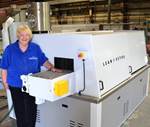The High Cost of Employee Retention
As a business owner, you know the most valuable resource your company has is its employees. And in today’s business environment, employees not only expect a proper salary for a job well done, they expect to be provided with benefits, not only for themselves but for their families as well.
As a business owner, you know the most valuable resource your company has is its employees. And in today’s business environment, employees not only expect a proper salary for a job well done, they expect to be provided with benefits, not only for themselves but for their families as well.
Competitive benefit packages generally include health, dental and life insurance, and some form of a retirement plan. Here, we focus on retirement plans (specifically the 401(k) plan) and how this simple tool may help you not only recruit better employees but retain them as well.
So, what is a 401(k)? As defined by the IRS, it is a qualified deferred compensation plan in which an employee can elect to have the employer contribute a portion of his or her cash wages to the plan on a pretax basis. For 2013, the maximum amount an employee could contribute to a 401(k) was $17,500. The maximum contribution between employee and employer was $51,000.'
There are several compelling reasons to establish a 401(k). For one thing, such a plan is a tax break for your business. Any company costs associated with operating a 401(k) plan can be deducted at tax time, including any contributions. Second, it’s a great tool for attracting and retaining employees through vesting schedules.
In a recent survey published by online media site Business News Daily, 40 percent of employees said they would leave their current employer for a similar job if it offered a 401(k) plan. The survey also concluded that most employees work harder and stay on the job longer once a 401(k) is introduced.
In addition 401(k) plans are one of the most flexible types of retirement plans available today. As the plan trustee, the company can determine who’s eligible to participate, whether it will match employee contributions and how long before employees become vested in the plan, and it can tie company goals to 401(k) incentives. In other words, the more profitable the company is, the greater the employee’s benefit.
A business owner also may wish to combine a profit sharing plan with a 401(k) in order to enhance the effectiveness and/or flexibility of the plan(s). Profit sharing plans don’t require a formula that ties the contributions to company profits.
No matter what type of plan you choose to help recruit or retain top employees, it seems obvious that retirement plans are here to stay. Their popularity has gained traction in the past few years, and there appears to be no slowing down in the near future. Regardless of the type retirement plan that you elect to implement, make sure you check with your financial advisor or CPA to ensure you understand any and all tax ramifications that these plans may have, not only for you, but for your company as well.
For more information:
RB Capital Management LLC
949-861-436
Related Content
-
Making Mentoring Work | MMT Chat Part 2
Three of the TK Mold and Engineering team in Romeo, Michigan join me for Part 2 of this MMT Chat on mentorship by sharing how the AMBA’s Meet a Mentor Program works, lessons learned (and applied) and the way your shop can join this effort.
-
Predictive Manufacturing Moves Mold Builder into Advanced Medical Component Manufacturing
From a hot rod hobby, medical molds and shop performance to technology extremes, key relationships and a growth strategy, it’s obvious details matter at Eden Tool.
-
Think Safety: Eliminate Hazards Throughout the Shop
The tooling community is taking advantage of new products for safer mold shops and molding facilities.















